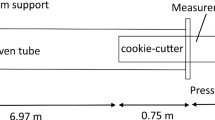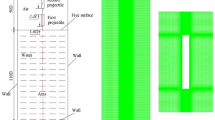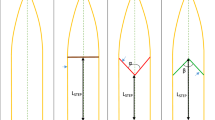Abstract
In this study, we numerically investigate a novel means to reduce blast overpressure to the rear of a muzzle-loaded cannon. Reduction in blast overpressure, and thus peak overpressure, leads to an increase in the number of allowed rounds that can be fired over a given period of time for the crew manning the system. New propellant leak methods are studied using numerical simulations, where the propellant gas is intentionally allowed to leak in front of the projectile into the precursor region (while the projectile is still in the bore). This is done through the addition of a bulge or leak channels in the tube. The focus of this work is on a large-caliber muzzle-loaded cannon at \(80^{\circ }\) (1,422 angular mils) elevation and with firing done at the max zone with the round and charge conditioned to ambient. We employ a hydrocode (ALE3D) to predict the blast overpressure for three types of geometries comprising five geometric configurations in total. These include one baseline configuration (i.e., with no modification) as well as four additional configurations with bulges and channels to allow propellant leak. The leaking of propellant gas into the precursor region leads to changes in the flow field associated with the precursor. In the case of channels, propellant leak results in a significantly reduced exit pressure ratio during projectile separation, and thereby, leading to a weaker primary blast wave. This in turn attenuates the peak overpressure to the rear of the muzzle without the aid of a muzzle device. For the channel leak method, at one monitored location, with the largest peak overpressure, a reduction of about 38 % was observed in peak overpressure as compared to the baseline case.




















Similar content being viewed by others
References
United States Army Public Health Command. Hazard Category, Acoustic Energy (2013). Web 17 April 2013. http://phc.amedd.army.mil/topics/workplacehealth/hha/Pages/HazardCategory-AcousticEnergy.aspx
Klingenberg, G., Heimerl, J.M.: Gun Muzzle Blast and Flash, Progress in Astronautics and Aeronautics, vol. 139. AIAA, Washington DC (1992)
Liepmann, H.W., Roshko, A.: Elements of Gas Dynamics, 1st edn. Wiley, New York (1957)
Christ, S., Sherman, P.M., Glass, D.R.: Study of the highly underexpanded sonic jet. AIAA J. 4(1), 68–71 (1966)
Abbet, M.: Mach disk in underexpanded exhaust plumes. AIAA J. 9(3), 512–514 (1971)
Eggins, P.L., Jackson, D.A.: Laser Doppler velocity measurements in an under-expanded free jet. J. Phys. D Appl. Phys. 7(14), 1894–1906 (1974)
Ashkenas, H., Sherman, F.S.: Structure and utilization of supersonic free jets in low density wind tunnels. In: Proceedings of NASA TCR CR-60423, NASA accession no. N6727207 (1966)
Love, E.S., Grigsby, C.E., Lee, L.P., Woodling, M.J.: Experimental and theoretical studies of axisymmetric free jets. In: Proceedings of NASA report TR-R-6 (1959)
Schmidt, E.M., Gion, E.J., Fansler, K.S.: Analysis of weapon parameters controlling the muzzle blast overpressure field. In: Proceedings of the 5th International Symposium on Ballistics, Toulouse, France (1980)
Klingenberg, G.: Investigation of combustion phenomena associated with the flow of hot propellant gases III: experimental survey of the formation and decay of muzzle flowfields and of pressure measurements. Combust. Flame 29(3), 289–309 (1977)
Erdos, J.I., Del Guidice, P.D.: Calculation of muzzle blast flowfields. AIAA J. 13(8), 1048–1055 (1975)
Kang, K.-J., Ko, S.-H., Lee, D.-S.: A study on impulsive attenuation for high-pressure blast flowfield. J. Mech. Sci. Technol. 22, 190–200 (2008)
Rehman, H., Hwang, S.H., Fajar, B., Chung, H., Jeong, H.: Analysis and atenuation of impulsive sound pressure in a large caliber weapon during muzzle blast. J. Mech. Sci. Technol. 25, 2601–2606 (2011)
Sandia National Laboratories. The CUBIT Tool Suite (2012). Web 17 April 2013. https://cubit.sandia.gov/
Christensen, R.B.: Godunov methods on a staggered mesh: an improved artificial viscosity. In: Proceedings of Report UCRL-JC-105269, Lawrence Livermore National Laboratory, November 1990
Nichols, A.L.: Users manual for ALE3D. In: Proceedings of Report LLNL-SM-433954, vol. 1. Lawrence Livermore National Laboratory, June 2010
Nichols, A.L.: Users manual for ALE3D. In: Proceedings of Report LLNL-SM-433954, vol. 2. Lawrence Livermore National Laboratory, June 2010
Noh, W.F.: CEL: a time-dependent, two-space-dimensional, coupled Euler–Lagrange code. Methods Comput. Phys. 3, 117–179 (1964)
Benson, D.J.: Computational methods in Lagrangian and Eulerian hydrocodes. Comput. Methods Appl. Mech. Eng. 99(2–3), 235–394 (1992)
Rajkowski, E.V.: Test Report AD-B173 029 (CSTA-7417). Aberdeen Test Center, Aberdeen Proving Ground (1993)
Acknowledgments
The authors would like to acknowledge several individuals for their contributions to this work. We would like to thank Andy Anderson, Willy Moss, and Sam Schofield from the Lawrence Livermore National Laboratory for their help in the development of the input deck for the ALE3D code and understanding the underlying discretization used in the code. We would also like to thank Don Carlucci at Benet Laboratories and the support of US Army Armament Research, Development and Engineering Center (ARDEC) Science Fellowship. The ARDEC Science Fellowship to the lead author was essential for this work. Additionally, we would like to thank Dr. Robert Dillon, Chief Scientist at Benet Laboratories, for his technical consultation in reviewing this work as well as Dan Crayon, Supervisor of the Armaments Health Monitoring and Mechatronics Branch at Benet Laboratories. The authors would also like to thank the reviewers and editor for their suggestions to improve the overall quality of the paper.
Author information
Authors and Affiliations
Corresponding author
Additional information
Communicated by O. Igra and H. Kleine.
Rights and permissions
About this article
Cite this article
Carson, R.A., Sahni, O. Numerical investigation of propellant leak methods in large-caliber cannons for blast overpressure attenuation. Shock Waves 24, 625–638 (2014). https://doi.org/10.1007/s00193-014-0522-7
Received:
Revised:
Accepted:
Published:
Issue Date:
DOI: https://doi.org/10.1007/s00193-014-0522-7




